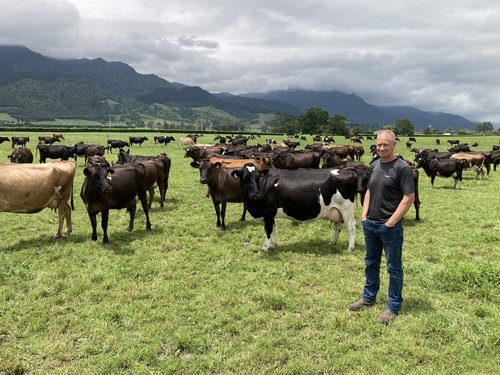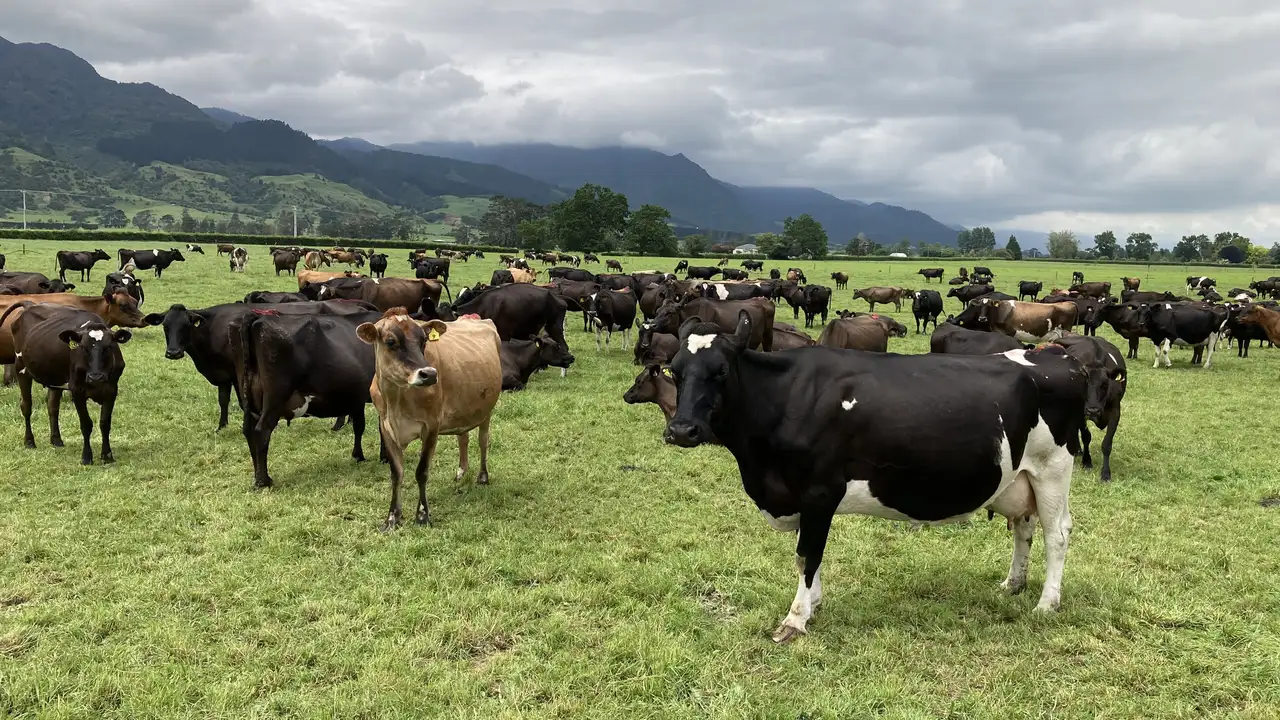When Kelvin Nicholson was selected for this article based on his herd’s consistently high reproductive performance, he was surprised.
“I just think what I'm doing is normal, I don't think anyone’s doing anything different, really.”
Although modest, Kelvin’s herds’ mating results are anything but, averaging a 78% 6 week in-calf rate and a 14% not in-calf rate in 10 weeks of mating.

Farm Facts
Business Type: Owner-operators with 1.5 staff
Location: Matamata-Piako
Farm Size: 81ha effective
Peak Cows: 280 (FJX), 285 winter
PSC: 25 July MA cows and R2 Heifers
Stocking Rate: 3.5 cows per ha
Farm System: System 2 (Summer irrigation)
Herd BW average: 269
Herd PW average: 317
Breed average: F8J8
Liveweight BV average: -8.1
Production: 105,000 kg MS/year budgeted, 1,300kg MS/ha, 375 kg Ms/cow. 2022/23 season 102,800 kg MS.
Production (3 year average): 107,933 kg MS, 385 kg MS/cow, 1,332 kg MS/ha.
Being a System 2 farm, Kelvin is focused on using every blade of grass and maximising his farm system.
“I read all the farming magazines and the brochures about different farming systems. But I run the system that’s here because it works and it's relatively simple.
“If we get 100,000 (kg MS) we've had a solid year. Anything above that we just think is a bonus. 100,000 is 1,235 per ha, just short of 1,250 a hectare on pasture only. I don't get too carried away about trying to produce more and more and more because I've done the 4.2 cows a hectare and every day you’re looking for feed, worrying about your decision making. The slightest mistake can have a big impact over that. So I try to keep it simple, make it easy for my staff and that's a fairly achievable target.”
Kelvin has gradually reduced his cow numbers over the years and found the farm’s best production years are when his herd is smaller.
“We started with 320 here, now I'm down to 280. We got to about the 280 mark and that was our best years production wise.”
Find out more about the key management practices that help Kelvin, Yvonne and their team consistently achieve their impressive repro results.
Repro overview

“I usually start monitoring cow condition from about March onwards,” Kelvin says.
“I pull out my lighter cows and dry them off about a month before the usual end of season date because it’s harder to get the weight on when you're on a high stocking rate and you don't have maize, you don't have anything else in the system.
“Especially when you have a tight calving pattern like we have, they’re not going to put any weight on a month out from calving unless you pile the feed into them. And then you're going to have a massive calf to deal with as well.”
“I like to have my calving date specific,” Kelvin says.
“I started nominating about five years ago based on gestation length. I try to get the best bull that I can that’s got a gestation length of zero or positive, not negative because if you get a bull that’s minus nine days gestation length on the first few days of mating, you’re calving a week earlier than you had planned.
“That has a big impact when you’re grass only because you run out of feed and that snowballs. It’s not as if I can just go and get another bucket load out of the bunker or something.”
When it comes to other traits, Kelvin also puts his faith in a bulls’ looks.
“I genuinely like a picture of the bull first, because if I like the look of the bull from a visual point of view, all its traits generally are pretty much where I want it to be.”
Kelvin says the cost of CIDR® inserts tends to be a deterrent for some, but he’s found the cost is counteracted by the improvement in his young cows getting in-calf earlier.
“Non-cycling cows are everywhere. If you don't deal with them, they end up empty. And they're usually your best ones, your youngest.
“Around 20% of the herd are CIDRs, and 90% of those would be the two- and three-year-olds. So I don't think I'm wasting money in that regard. I think it's well worth it.”
Kelvin gets his vet to check whether the cows are cycling about ten days before the planned start of mating.
“If there are cows the vet thinks are cycling, I’ll leave them because I trust my vet. Then the non-cyclers get CIDR'd so they’re ready on day two and three.”
By having the cows ready to be mated in the first couple of days, they get two opportunities to get in-calf to AB, Kelvin says.
“If you can get your good, young cows calving earlier, they get longer to recover before the next mating. If you don't do anything, you can end up chasing your tail.”
Although Kelvin would like to use other types of intervention, he feels limited by his farm size.
“If it was practical enough I’d run a preferential treatment mob but we have big paddocks and it would mean a lot of fences which at a busy time of the year becomes demanding. Again, simplicity is paramount.”
Farming is all about observation, Kelvin says.
“You don't pick up a lame cow without looking at it, you don't pick up a sick cow without looking at it. I've always said to my staff, when you bring the cows in, just keep your eyes open. Don’t look at your phone or look elsewhere because you never know what you’ll find.
“Like many farmers, I know my cows. I don’t have to be up close to recognise a cow and know her tag number. I practically know every cow and her number but often I forget people’s names.”
Kelvin’s farm manager, Ron, has been with him for seven years and his milker Jody, has been with him for 10.
“We've been so blessed with such good staff. I keep saying when they go, I'm not sure what we will do,” Kelvin says.
Kelvin believes he’s been able to retain his staff because he prioritises treating them well.
“If you have happy staff, they’ll stay. It's kind of simple.
“Treat them how you want to be treated if you were a staff member. Always say thank you every day, morning and night for milking the cows. Just a simple thank you goes a long way. I learned that way back when I was young fellow myself. The farm manager just kept saying thank you to the staff all the time. I asked him why he said thank you so much. ‘Because they appreciate it’. And they do.
“We are a team. I can’t do it without them.”

